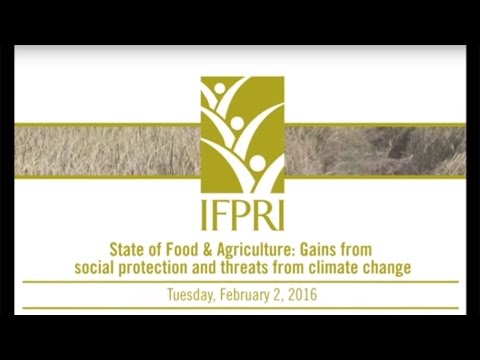Social protection programs−broadly defined as initiatives offering cash or in-kind assistance to the poor−have expanded rapidly in recent decades, now covering an estimated two billion people living in developing countries. Such broad coverage, which accounts for roughly one-third of the total population living in these countries, has contributed to a dramatic decline in extreme poverty, with the proportion of extremely poor (those living on less than US$1.25 a day) dropping from 43 percent in 1990 to around 17 percent today. Yet research shows that simply scaling up existing social protection programs will not be enough to pull those who remain behind out of the vicious poverty trap.
Why is this? According to Rob Vos from the Food and Agriculture Organization of the United Nations (FAO), social protection only offers a sustainable pathway out of poverty if there is inclusive growth in the economy. Presenting key findings from The State of Food and Agriculture (SOFA) 2015 report, Vos underscored the fact that extreme poverty remains highly concentrated in rural areas where smallholder subsistence farming is the main economic driver. The highest concentrations are found in South Asia and Africa south of the Sahara, where an estimated 80 percent of the rural population still has no access to any form of social protection. Thus, linking social protection to agricultural and rural development efforts has many practical advantages for pulling the greatest number of people out of extreme poverty.
“Social protection can be a catalyst for agricultural development and a way for the rural poor to break out of poverty,” said Vos. “[This is] because it may help them manage their risk better, help stimulate food production through farmers that can invest more in their future, and through that, help raise their nutrition and food security further down the road.”
To illustrate this point, the 2015 SOFA report highlighted the impacts of global climate change on household decision making among the rural poor. Citing a number of recent studies, the report revealed that rural households are at high risk due to changes in weather variability. For example, a sudden change in rainfall patterns can result in critical delays in planting staple crops, thereby causing income losses during harvest season. In the absence of savings or access to credit, households often respond by selling off assets, seeking off-farm employment, reducing food consumption, and even pulling children out of school to assist with household chores or income generation activities. Collectively, such short-term coping strategies can carry long-term costs on the health and economic well-being of household members: costs that social protection could help mitigate.
By helping to overcome liquidity constraints and poor access to credit, social protection not only prevents rural households from falling further into poverty but also allows them to invest and build assets for the future. In his presentation, Vos highlighted findings from the 2015 SOFA report showing that recipients of social protection increased their investments in both agricultural production and non-farm income generation activities. Thus, on-farm production and yields rise alongside increases in off-farm income generation, leaving households more resilient when the next shock arrives.
“Social protection,” Vos declared, “promotes investment and transforms individuals’ capacities to take their lives into their own hands.”
Social protection programs also have positive impacts that reach far beyond recipient households. Several of the country-level studies covered in the 2015 SOFA report showed that when beneficiaries received cash transfers, they generally spent the additional income on local goods and services, which carried important spillover benefits on the local economy. For example, a study conducted by FAO on Ghana’s Livelihood Empowerment Against Poverty (LEAP) cash transfer program revealed that program beneficiaries spent approximately 80 percent of their income within the local economy, with rate of 2.5 in economic return on investment in the program. According to Vos, such multiplier effects are boosted significantly when rural households have greater linkages to agricultural markets.
Dan Gilligan, Deputy Division Director of IFPRI’s Poverty, Health and Nutrition Division, praised FAO’s efforts to bring greater awareness to the many linkages between social protection and agriculture, noting that the report also makes a strong case for investing in more research into exploring and documenting the impact of these linkages. Gilligan shared that he and his colleagues already have begun this work at IFPRI, with plans to undertake related research under the CGIAR Research Program on Policies, Institutions, and Markets (PIM) starting next year.
According to Gilligan, the impacts of social protection programs on boosting agricultural production, food security, and incomes are well documented, but the evidence suggests that the impacts could be greater still by “twinning” social protection and agriculture at the programming level. The impacts of social protection on nutrition, meanwhile, are much less documented, leading Gilligan and some of his colleagues to revisit existing household survey data from long-term studies in Bangladesh and Ethiopia and ask: Are we getting more out of these programs than we previously thought?
Social protection programs also can have lasting effects as investments in human capital, Gilligan said, noting that evidence shows it increases school attendance and cognitive development. “If it can be designed to improve nutrition too, then we’re talking about really substantial investments in human capital,” he said. “You’re improving the abilities of tomorrow’s workforce, who are going to be your farmers [and] decision makers.”







